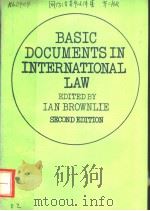《INTERNATIONAL LAW VOLUME ONE SECOND EDITION》
| 作者 | 编者 |
|---|---|
| 出版 | STEVENS & SONS |
| 参考页数 | 631 |
| 出版时间 | 1970(求助前请核对) 目录预览 |
| ISBN号 | 无 — 求助条款 |
| PDF编号 | 812874918(仅供预览,未存储实际文件) |
| 求助格式 | 扫描PDF(若分多册发行,每次仅能受理1册) |
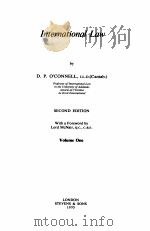
Part One GENERAL PRINCIPLES3
1.THE FORMATION OF INTERNATIONAL LAW3
The Character of the Formative Process3
(a) International law as customary law3
(b) The distinction between the general principles of law and custom5
(c) The distinction between the substance of international law and the formal law-making instrumentality: the ambiguity of the word “sources”7
(d) The distinction between practice and custom8
“Implicit” International Law9
(a) General principles of law9
(b) Principles automatically part of international law and principles merely suited to incorporation in it10
(c) Equity as a general principle14
“Explicit” International Law15
(a) The nature of customary law15
(b) Acts necessary to create customary rules17
(c) The distinction between lex lata and lex ferenda19
(d) Comity20
Law-Formative Agencies21
(a) Treaties21
(Ⅰ) Treaties as evidence of the law22
(Ⅱ) The so-called “law-making” treaty22
(b) Organisational action25
(c) Codification29
(d) Judicial decisions31
(e) Text writings35
2.THE RELATIONSHIP BETWEEN INTERNATIONAL LAW AND MUNICIPAL LAW38
The Theory of the Relationship: Monism and Dualism38
(a) Monism39
(b) Dualism42
(c) Inverted monism42
(d) The theory of harmonisation43
The Doctrine of the Courts on the Relationship of International Law and Municipal Law46
(a) In international courts46
(b) In municipal courts49
(Ⅰ) The transformation doctrine49
(Ⅱ) The adoption doctrine49
(Ⅲ) The harmonisation doctrine50
(c) The canons of harmonisation51
(Ⅰ) The rules of construction51
(Ⅱ) The rules of proof of law53
(Ⅲ) Constitutional provisions for the supremacy of inter-national law in the event of conflict53
The Problem of the Internal Operation of Treaties54
Municipal Law Rules in the Relationship of International Law and Municipal Law56
(a) English law systems56
(Ⅰ) Relationship between common law and customary international law56
(Ⅱ) Relationship between internal law and treaty operation58
(b) The law of the United States61
(Ⅰ) Relationship between internal law and customary international law61
(Ⅱ) Relationship between internal law and treaty operation62
(c) Civil law systems65
(Ⅰ) France65
(1) Relationship between internal law and customary international law65
(2) Relationship between internal law and treaty operation67
(Ⅱ) Italy68
(1) Relationship between internal law and customary international law68
(2) Relationship between internal law and treaty operation70
(Ⅰ) Specific legislative enactments70
(Ⅱ) Use of the executive order70
(Ⅲ) Automatic adoption as provided under Article 10 .70
2.THE RELATIONSHIP BETWEEN INTERNATIONAL LAW AND MUNICIPAL LAW—cont.71
Municipal Law Rules in the Relationship of International Law and Municipal Law——cont.71
(c) Civil Law systems——cont.71
(Ⅲ) Germany71
(1) Relationship between internal law and customary international law71
(Ⅰ) The Empire71
(Ⅱ) The Weimar Republic72
(Ⅲ) The Federal Republic72
(2) Relationship between internal law and treaty operation74
(Ⅰ) The Empire74
(Ⅱ) The Weimar Republic75
(Ⅲ) The Federal Republic75
(Ⅳ) Other civil law systems76
Conclusion79
3.PERSONALITY IN INTERNATIONAL LAW80
The Problem of Terminology and Approach80
Personality and the Concept of Sovereignty83
(a) De facto insurgent governments86
(Ⅰ) The character of a de facto government86
(Ⅱ) The capacity of a de facto government to bind the State89
(Ⅲ) The extent of the capacity of a de facto government91
(1) The generality of the de facto government92
(2) The generality of its acts93
(b) International organisations94
(Ⅰ) History of personality of international organisations94
(Ⅱ) Cognisance of juristic personality of international organisations in municipal law96
(Ⅲ) The functional approach to proving capacity in an international organisation98
(Ⅳ) Consideration of function in the ascertainment of capacities100
(1) The legal status of property and offices100
(2) Immunities of functionaries102
(3) Contractual capacity of international organisa-tions103
(4) Territorial administrative capacity and peace-keeping104
(c) The individual106
(Ⅰ) Rights and duties of individuals under customary international law106
(Ⅱ) Acquisition of rights by individuals under treaty111
4.PROOF OF INTERNATIONAL FACT114
English Law114
(a) The use of the executive certificate114
(b) The theoretical basis of certification116
(c) The conclusiveness of an executive certificate117
(d) The limits of certification118
(e) Proof of international fact otherwise than by executive certification119
The Law of the United States119
(a) The use of the suggestion119
(b) The conclusiveness of the suggestion120
Civil Law Systems122
Part Two RECOGNITION127
5.THE THEORY AND MODES OF RECOGNITION127
The Theory of Recognition127
Types of Situation Calling for Recognition128
The Independence of New States128
(a) The problem of personality: the constitutive versus the declaratory schools128
(b) The supposed duty to recognise a new State131
(c) The conditions for recognition132
Recognition of Change of Government134
(a) Is formal recognition of change of government necessary? The Estrada doctrine134
(b) The supposed duty to recognise change of government; the qualifications for recognition135
(Ⅰ) The qualification of effectiveness136
(Ⅱ) The qualification of constitutional legitimacy: The Tobar doctrine and the Wilson policy137
(Ⅲ) The qualification of willingness to fulfil international obligations140
Recognition of Territorial Change140
(a) History of recognition and non-recognition of territorial changes.141
(b) Non-recognition of title founded in illegal act146
(c) What is involved in non-recognition147
Recognition of Belligerency148
(a) The nature of recognition of belligerency.The constitutive and declaratory views148
(b) The supposed distinction between recognition of belligerency and recognition of insurgency151
5.THE THEORY AND MODES OF RECOGNITION——cont.152
Types of Situation Calling for Recognition——cont.152
Recognition of Belligerency——cont.152
(c) The effect in municipal courtsof non-recognition of belligerency152
(d) The supposed duty to recognise belligerency152
Modes of Recognition153
The Form of Recognition: Implied Recognition153
(a) The reception of diplomatic representatives154
(b) The entry into treaty relationships with unrecognised govern-ments155
(c) Recognition and membership of international organisations155
(Ⅰ) Recognition of new States by international organisa-tions157
(Ⅱ) Decision on credentials of rival governments158
(d) Revocability of recognition159
(e) Recognition of a government as the government de jure and recognition of a government as the government de facto160
The Effects of Recognition and Non-Recognition Internationally162
The Effects on Treaties162
The Effect on Authorisation of Agency163
The Effect on the Flag164
The Effect on International Liability164
Summary of Conclusions on Recognition165
6.RECOGNITION AND NON-RECOGNITION AND THE COURTS166
Judicial Cognisance of Unrecognised Governments166
(a) English law167
(Ⅰ) The unrecognised government as plaintiff168
(Ⅱ) The unrecognised government as defendant168
(Ⅲ) Cognisance of legal acts of an unrecognised government168
(b) The law of the United States172
(Ⅰ) Locus standi of unrecognised governments172
(Ⅱ) Cognisance of legal acts of an unrecognised government175
(c) Civil law systems181
(Ⅰ) The unrecognised government as plaintiff181
(Ⅱ) The unrecognised government as defendant181
(Ⅲ) Cognisance of legal acts of an unrecognised govern-ment182
(1) Personal status182
(2) Acquired rights182
Judicial Cognisance of Recognised Governments183
Retroactivity of Recognition185
(a) The principle of retroactivity185
6.RECOGNITION AND NON-RECOGNITION AND THE COURTS——cont.186
Retroactivity of Recognition——cont.186
(b) The principle of retroactivity and the distinction between recognition of a government as the government de facto and recognition of a government as the government de jure186
(c) Retroactivity and the co-incidence of two governments186
(Ⅰ) Sovereign activity, intra- and extraterritorial, of the rival governments186
(Ⅱ) Claims by the old government de jure arising before recognition191
(Ⅲ) Judgments in favour of or against the old government191
(d) The date to which the recognition is retroactive191
Part Three TREATIES195
7.THE MAKING OF TREATIES195
The Categories of Treaties195
Types and Nomenclature of Treaties195
(a) Charter, covenant, constitution, pact and statute196
(b) Treaty, convention, act197
(c) Protocol197
(d) Declaration198
(e) Agreement, arrangement, exchange of notes, etc.201
(f) Pactum de contrahendo202
(g) Oral agreements202
(h) Agreed minutes203
(i) Contracts ostensibly of private character.Whether the direct interest of the State assimilates them to treaties204
The Vienna Convention on the Law of Treaties205
The Tests for Determining What is a Treaty205
The Differing Usages in International Law and Municipal Law of the Terms “Treaty” and “Agreement”: The Executive Agreement in the Law of the United States206
Annex: Select List of Executive Agreements208
The Process of Treaty Making210
The Parties to a Treaty210
The Signature of Treaties210
(a) Full Powers211
(Ⅰ) The theory of Full Powers211
(Ⅱ) Relationship between Full Powers and credentials213
(Ⅲ) Legal nature of Full Powers213
(Ⅳ) The distinction between General and Special Full Powers214
7.THE MAKING OF TREATIES——cont.214
The Process of Treaty Making——cont.214
The Signature of Treaties——cont.214
(b) Who has inherent capacity to sign a treaty?214
(Ⅰ) United States practice214
(Ⅱ) United Kingdom practice214
(Ⅲ) The categories of persons regarded by international law as having inherent power to contract215
(c) Ultra vires signature216
(Ⅰ) Signature by unauthorised agents or in excess of authority217
(Ⅱ) Signature in excess of constitutional powers219
Ratification220
(a) The discretionary character of ratification220
(b) When ratification is required222
(c) The legal nature of an unratified treaty222
(d) The necessity for ratification224
(e) Deposit of ratifications: The date of coming into force225
(f) The non-retroactivity of ratification225
Accession and Adhesion229
Reservations to Treaties229
(a) The theory of reservations229
(b) Must the right to reserve be express in the convention?232
(c) The criteria for determining the right to reserve and the right to object to reservations233
(d) Must other States party to the convention consent explicitly to a reservation in order to bind themselves vis-a-vis the reserving State ?234
(e) The distinction between general and limited reservations236
(f) Does an incompatible reservation frustrate adherence to the treaty altogether, or is the reserving State a party without benefit of the reservation?237
(g) Summary of conclusions on reservations238
(h) Interpretative reservations239
(i) Withdrawal of reservations239
The Effect of Duress and Error239
The Effect of Invalidity241
Registration of Treaties241
Deposit of Treaties243
Ius Cogens244
8.THE OPERATION OF TREATIES246
The Effects of a Treaty246
Most-Favoured-Nation Clauses248
The Interpretation of Treaties251
8.THE OPERATION OF TREATIES——cont.253
The Interpretation of Treaties——cont.253
(a) Interpretation by reference to matters intrinsic in the terms of the treaty253
(b) Interpretation by reference to matters extrinsic to the terms of the treaty259
(Ⅰ) Resort to the preamble: the “purposes” and “prin-ciples” of an organisation259
(Ⅱ) Resort to treaties in pari materii260
(Ⅲ) Resort to the common interpretation of the parties261
(Ⅳ) Resort to customary international law261
(Ⅴ) Resort to traditional policies and practices of a signatory261
(Ⅵ) By reference to the situation of the parties at the time the treaty was contracted262
(Ⅶ) Resort to “travaux preparatoires”262
(c) Interpretation of treaties by municipal courts264
Termination of Treaties265
(a) Execution265
(b) According to the terms266
(c) Mutual consent266
(d) Desuetude266
(e) Denunciation266
(f) Loss of personality of a party268
(g) War268
(h) Supersession of treaties through conflict272
(Ⅰ) Inconsistency between treaties of the same order272
(Ⅱ) Inconsistencybetween treaties of “higher” and “lower” order274
(Ⅲ) The compatibility of most-favoured-nation clauses and customs unions274
(i) Impossibility of performance277
Severability of Treaty Clauses277
Revision of Treaties278
The Rebus sic Stantibus Doctrine278
Status of Lapsed Treaties280
Part FourSO VEREIGNTY283
9.THE LEGAL CONCEPT OF THE STATE283
The Definition of State in International Law283
The Problem of Definition283
The Attributes of Statehood284
9.THE LEGAL CONCEPT OF THE STATE——cont.285
The Definition of “State” for the Purposes of International Organisa-tion285
(a) Membership of the League of Nations and United Nations285
(b) Membership of the Specialised Agencies and other inter-national organisations286
(Ⅰ) Organisations open to sovereign States286
(Ⅱ) Organisations open to dependent territories287
(c) Debated qualications for membership287
(d) “States” in the settlement of disputes by the Security Council288
Sovereign Entities which are Not Typical States289
(a) The Vatican and the Papacy289
(b) San Marino, Monaco and Andorra290
(c) Neutralised States: Switzerland and Austria291
(d) Cyprus292
Unions293
(a) Personal unions293
(b) Real unions294
(c) Economic unions294
Federal States295
The Fundamental Rights of States297
Independence.298
(a) Definition of “independence”298
(b) The content of independence299
(Ⅰ) The rule against intervention by other States299
(Ⅱ) So-called “economic intervention”300
(Ⅲ) Distinction between aid to the de jure government and aid to rebels301
(Ⅳ) Belligerent action in pursuance of legal redress302
(Ⅴ) Non-belligerent action in pursuance of legal redress304
(Ⅵ) Summary of rules on non-intervention304
(c) The Monroe Doctrine306
(d) The rule against intervention by the United Nations308
(Ⅰ) The expression “intervene”308
(1) Does the inclusion of an item in the agenda consti-tute intervention?308
(2) Does a recommendation constitute interven-tion ?309
(3) Does the examination of the domestic policy of a member constitute intervention?309
(4) Must the Security Council settle the question of competence under Chapter Ⅶ before taking action which might prejudice domestic jurisdic-tion ?310
9.THE LEGAL CONCEPT OF THE STATE——cont.310
The Definition of “State” for the Purpose of International Organisa-tion——cont.310
Independence——cont.310
(d) The rule against intervention by the United Nations——cont.310
(Ⅱ) The expression “matters essentially within the domestic jurisdiction”310
(1) Can a matter governed by international law be within the reserved domain?311
(2) Can a matter under the United Nations Charter be within the reserved domain?311
(Ⅰ) Charter provisions on human rights312
(Ⅱ) Charter provisions on self-determination312
(Ⅲ) Charter provisions on the maintenance of peace313
(e) Non-intervention and friendly relations among States313
Self-Defence315
(a) The problem of defining self-defence315
(b) Self-defence as defined in Article 51, United Nations Charter316
(c) Self-defence and legal redress318
(d) The content of the right of self-defence318
(e) Collective self-defence319
Legal Equality320
(a) The problem of defining “equality”320
(b) Is equality a legal conception?321
(c) The legal content of equality322
(d) The majority vote principle in international organisations324
10.TITULAR, RESIDUAL AND DISTRIBUTED SOVEREIGNTY325
Examples of Titular, Residual and Distributed Sovereignty325
(a) The Ryukyu Islands, 1945-325
(b) The Panama Canal Zone326
Condominium327
Leases328
Trust Territories330
(a) The mandate and trust systems330
(b) Sovereignty in mandated and trust territories332
(c) Nationality in mandated and trust territories334
(d) United Nations action on colonialism335
(e) Are the Administering Authorities obliged to implement the recommendations of the General Assembly and Trusteeship Council?336
(f) The trusteeship agreements337
(g) The responsibilities and functions of the United Nations in relation to the administration of South West Africa339
10.TITULAR, RESIDUAL AND DISTRIBUTED SOVEREIGNTY——cont.341
Trust Territories——cont.341
(h) Administrative union of trust and other territories341
Protectorate341
The Associated States344
11.THE COMMONWEALTH, THE FRANCOPHONE SYSTEM AND THE NETHERLANDS REALM346
The Commonwealth346
The Colonial Period346
The Transitional Period348
The Inter-Se Doctrine350
The Present Position350
Commonwealth Preference352
(a) The Admiralty jurisdiction in the British Commonwealth353
(Ⅰ) The Admiralty jurisdiction354
(Ⅱ) Jurisdiction of colonial courts354
(Ⅲ) The British Commonwealth355
The French Community and System of Co-operation356
The Franc Zone359
The Netherlands Realm359
Part Five SUCCESSION365
12.STATE SUCCESSION365
Definition of State Succession365
The Relationship between State Continuity and State Succession366
The Theory of State Succession367
Effect of Change of Sovereignty on Treaties368
(a) Personal treaties368
(b) Assignment of treaties371
(c) Dispositive treaties373
(d) Multilateral treaties374
(e) Extension of treaties of the successor State to territory incor-porated in it376
Effect of Change of Sovereignty on Acquired Rights377
(a) The definition of “acquired rights”377
(b) Protection of acquired rights and the doctrine of Act of State378
(c) The extent of protection of acquired rights379
12.STATE SUCCESSION——cont.381
Effect of Change of Sovereignty on Contractual Obligations of the Predecessor State381
(a) Subrogation, frustration, restitution381
(b) Economic concessions382
(c) Administrative contracts383
Effect of Change of Sovereignty on the National Debt383
(a) The national debt384
(b) Localised debts385
(c) Local debts385
Effect of Change on Sovereignty on Delictual Claims386
Effect of Change of Sovereignty on the Public Domain387
Effect of Change of Sovereignty on the Legal and Judicial System388
Effect of Change of Sovereignty on the Administration390
Effect of Change of Sovereignty on the Nationality of the Inhabitants of Absorbed Territory391
13.SUCCESSION OF GOVERNMENTS394
14.SUCCESSION OF INTERNATIONAL ORGANISATIONS396
Part Six TERRITORY403
15.TERRITORY403
Relationship between Territory and Sovereignty403
The Distinction between Imperium and Dominium: The Theory of Territory403
Acquisition of Territory405
The Problem of Characterisation of Sovereign Acts in the Acquisi-tion of Territory: Definition of Occupation, Prescription and Historic Rights405
Modes of Acquisition408
(a) Occupation408
(Ⅰ) History of the doctrine: the value of discovery408
(Ⅱ) The concept of effectiveness in occupation409
(1) Acts necessary to prove sovereignty409
(2) Relativity of probative value of sovereign acts to circumstances of particular territories411
(3) Extent of title based on occupation413
(4) The distinction between immediate occupation and occupation by consolidation415
(5) The distinction between title by occupation and inchoate title416
15.TERRITORY——cont.417
Acquisition of Territory——cont.417
Modes of Acquisition——cont.417
(a) Occupation——cont.417
(Ⅱ) The concept of effectiveness in occupation——cont.417
(6) The Act of Berlin 1885417
(7) Significance of unauthorised acts of private persons417
(Ⅲ) The importance of the conception of contiguity419
(b) Historic rights421
(c) Prescription422
(Ⅰ) The nature of prescriptive title422
(Ⅱ) The conduct required of both parties to a prescriptive claim423
(Ⅲ) The relevance of absence of protest424
(Ⅳ) The doctrine of uti possidetis in South and Central America and the theory of constructive possession426
(Ⅴ) Settlement of boundary disputes on the basis of treaty and conduct427
(d) Accretion428
(Ⅰ) Deltas and other natural appendages428
(Ⅱ) Accretion, avulsion and the change of riverbed429
(e) Annexation431
(Ⅰ) Whether annexation is still a mode of acquisition in international law431
(Ⅱ) The distinction between conquest and annexation432
(Ⅲ) The forms of annexation433
(Ⅳ) The conditions for annexation: premature annexation435
(f) Cession436
(Ⅰ) Modes of cession436
(Ⅱ) The question of delivery437
(Ⅲ) Jurisdictional authority up to the moment of delivery438
(Ⅳ) Cession by native princes440
(g) Debellatio441
(Ⅰ) The Status of Germany after 1945441
(Ⅱ) The Status of Berlin 1948-442
Loss of Territory443
Revolt and Secession443
Dereliction444
(a) Conversion to terra nullius444
(b) Dereliction by treaty and the problem of succession to sovereignty445
Polar Regions448
The Arctic448
Antarctica450
16.MARITIME TERRITORY454
The Territorial Sea454
Historical Introduction454
(a) The seventeenth century455
(b) The eighteenth century456
(c) The nineteenth century457
(d) The Arbitrations458
(e) The conferences on the territorial sea459
The Extent of Coastal Claims461
The Juridical Character of the Territorial Sea467
(a) The theories on the subject467
(Ⅰ) The territorial sea as an aggregation of jurisdictional rights467
(Ⅱ) The territorial sea as a subject of sovereignty but out-side the national boundary467
(Ⅲ) The territorial sea as a bundle of servitudes468
(Ⅳ) The territorial sea as a subject of conservation rights468
(Ⅴ) The territorial sea as part of the public domain468
(b) The juridical character of the territorial sea in international law469
(c) The juridical character of the territorial sea in municipal law469
(Ⅰ) English law470
(1) Judicial decisions on the extent of the realm470
(2) The Territorial Waters Jurisdiction Act 1878471
(3) The application of the decision in r.v.Keyn to Canada, India and Australia472
(Ⅱ) The law of the United States: the Tidelands Dispute473
(Ⅲ) Civil law systems475
Measurement of the Territorial Sea475
(a) The technique of measurement475
(b) The boundary between two States476
(c) The base for measurement476
(d) Measurement from rocks and islands480
(Ⅰ) What is an island?480
(Ⅱ) Islands within and outside the territorial sea481
(Ⅲ) Artificial constructions482
(Ⅳ) Archipelagos482
The Distinction between the Territorial Sea and Internal Waters483
Bays484
The Problem of Dening a Bay in International Law484
(a) The visual test484
(b) The effective control test486
(c) The geographical test486
The Criterion of “Bay” in Constitutional Law: The Relation be-tween the Definition in Municipal Law and in International Law488
16.MARITIME TERRITORY——cont.490
Bays——cont.490
The Supposed Criterion of Historic Bays490
The Geographical Criterion in Modern International Law493
(a) Pre-Geneva Conference 1958493
(b) The criterion in the Final Act of the Geneva Conference 1958494
Straits495
What is a Strait?495
The Right of Innocent Passage through Straits498
Actual Regimes of Straits501
(a) Straits of Gibraltar501
(b) Straits of Magellan501
(c) The Danish Straits501
(d) The Bosphorus and Dardanelles501
The Continental Shelf503
The History of the Topic503
The Continental Shelf as a Geographical Phenomenon504
Rights in Respect of the Continental Shelf505
The Proclamations505
The Extent of the Continental Shelf509
Division of the Continental Shelf511
(a) Opposite States511
(b) Adjacent States512
Continental Shelves of Islands513
Legislation Respecting the Continental Shelf513
(a) The United Kingdom Continental Shelf Act 1964513
(b) The United States Territorial Waters and Continental Shelf Fishery Act 1964514
The resources of the Continental Shelf514
The Seabed of High Seas515
17.AIRSPACE AND AIR LAW518
Airspace518
The Juridical Character of Airspace518
Classification of Aircraft for the Purposes of Regulation520
The Law Applicable to Aircraft in Flight524
(a) The Tokyo Convention on Offences and certain Other Acts Committed on Board Aircraft 1963525
(b) United Kingdom law526
(c) United States law527
The Chicago Convention 1944527
The Warsaw Convention 1929528
(a) International carriage528
(b) Limitation of liability and the burden of proof530
17.AIRSPACE AND AIR LAW——cont.532
Airspace——cont.532
The Warsaw Convention 1929——cont.532
(c) Liability under Article 25532
(d) The Guadalajara Convention supplementing the Warsaw Convention 1961534
(e) Judicial jurisdiction under the Warsaw Convention534
The Rome Convention on Damage Caused by Foreign Aircraft to Third Parties on the Surface535
Outer Space536
Application of the Chicago Convention to Space Bodies539
Liability for Damage Caused by Space Vehicles540
18.RIGHTS IN RESPECT OF FOREIGN TERRITORY544
International Servitudes544
The Terminology and Substance of “Servitude”544
The Elements of a Servitude547
Types of Servitudes547
(a) Freedom of transit547
(b) Economic use of waters549
(c) Customs-free zones549
(d) Fishery rights550
(e) Demilitarised and neutralised areas551
(f) Other localised rights551
Customary Restraints on Sovereignty552
The Significance of Analogous Instances552
(a) Freedom of access and transit552
(b) Access to enclaves553
(c) Access to the sea553
The Law Relating Generally to Transit554
The Conditions of Access and Transit555
International Rivers556
Definition of an International River556
Possible Legal Regimes of International Rivers557
Control of Waters558
(a) The Nile560
(b) The Columbia River561
(c) Middle East rivers562
(d) International action on control of waters562
(e) The principle of “equitable apportionment”563
Navigation565
(a) History of river internationalisation565
(b) Whether there is a customary rule of freedom of navigation567
(c) The Barcelona Convention 1921569
18.RIGHTS IN RESPECT OF FOREIGN TERRITORY——cont.570
International Rivers——cont.570
Navigation——cont.570
(d) Actual navigation rights on international rivers570
(Ⅰ) European and African rivers571
(1) The Rhine571
(2) The Danube572
(3) The Scheldt574
(4) The Po574
(5) The Vistula574
(6) The Elbe, the Oder and the Niemen575
(7) African rivers575
(8) The Mekong576
(Ⅱ) The rivers of the American Hemisphere576
(1) The Mississippi576
(2) The St.Lawrence577
(3) The Alaskan rivers578
(4) The St.John578
(5) The Columbia578
(6) The Colorado and the Rio Grande578
(7) The Amazon.578
(8) The Orinoco579
(9) The Plate579
The River as an International Boundary579
Interoceanic Canals580
The Process of Internationalisation580
The Incidents of Internationalisation581
(a) Merchant ships582
(b) Warships582
The Actual Regime of Canals582
(a) Suez Canal582
(Ⅰ) The Convention of 1888.584
(Ⅱ) The practice since 1888585
(b) Panama Canal587
(c) Kiel Canal589
International Law of Telecommunications590
Obligations in Respect of Foreign Territory591
The Standard of Care591
River Pollution593
Nuclear Damage593
(a) The Nuclear Test Ban Treaty 1963593
(b) Treaty liability for nuclear damage594
(c) Treaty on non-proliferation of nuclear weapons594
Part Seven JURISDICTION599
19.THE THEORY OF JURISDICTION599
20.MARITIME JURISDICTION604
21.PERSONAL JURISDICTION: NATIONALITY670
22.PERSONAL JURISDICTION: ALIENS693
23.PERSONAL JURISDICTION: EXTRADITION AND ASYLUM720
24.PERSONAL JURISDICTION: HUMAN RIGHTS742
25.JURISDICTION WITH RESPECT TO ALIEN ACQUIRED RIGHTS762
26.EXTENT OF OPERATION OF SOVEREIGN ACTS794
Part Eight IMMUNITY FROM JURISDICTION799
27.SOVEREIGN IMMUNITY841
28.DIPLOMATIC AND CONSULAR PRIVILEGES AND IMMUNITIES887
Part Nine STATE RESPONSIBILITY941
29.THE THEORY OF STATE RESPONSIBILITY941
30.STATE RESPONSIBILITY: THE TORT SITUATION962
31.STATE RESPONSIBILITY: THE CONTRACT SITUATION976
32.RESPONSIBILITY WITH RESPECT TO MONETARY SOVFREIGNTY1011
Part Ten INTERNATIONAL LITIGATION1029
33.THE CLAIM1029
34.THE TRIBUNAL1068
35.THE HEARING1090
36.REPARATION FOR INTERNATIONAL WRONGS1114
Tables and Indices1127
1970《INTERNATIONAL LAW VOLUME ONE SECOND EDITION》由于是年代较久的资料都绝版了,几乎不可能购买到实物。如果大家为了学习确实需要,可向博主求助其电子版PDF文件(由 1970 STEVENS & SONS 出版的版本) 。对合法合规的求助,我会当即受理并将下载地址发送给你。
高度相关资料
-

- INTERNATIONAL LAW SECOND EDITION REVISED AND ENLARGED
- 1934 D. APPLETON-CENTURY COMPANY NEW YORK LONDON
-

- MODERN ENGLISH VOLUME ONE SECOND EDITION
- HARCOURT BRACE JOVANOVICH
-
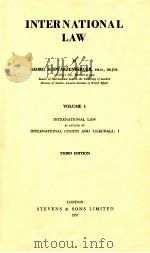
- INTERNATIONAL LAW VOLUME 1 THIRD EDITION
- 1957 STEVENS & SONS LIMITED
-

- CUSTOM IN PRESENT INTERNATIONAL LAW SECOND REVISED EDITION
- 1993 MARTINUS NIJHOFF PUBLISHERS
-
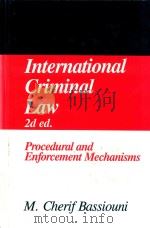
- International Criminal Law Second Edition Volume II Procedural and Enforcement Mechanisms
- 1999 Transnational Publishers
-
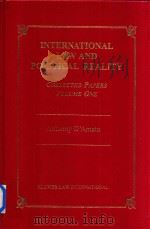
- International Law and Political Reality Collected Papers Volume One
- 1995 Kluwer Law International
-

- Textbook on International Law Second Edition
- 1993 Blackstone Press Limited
-

- PEDIATRIC ORTHOPAEDICS VOLUME ONE SECOND EDITION
- 1986 J.B.LIPPINCOTT COMPANY
-

- AUSTRALIAN PRIVATE INTERNATIONAL LAW SECOND EDITION
- 1987 THE LAW BOOK COMPANY LIMITED
-

- THE SOCIAL WORKER'S LAW BOOK AN INTRODUCTORY MANUAL
- 1980 MCGRAW-HILL BOOK COMPANY(UK)LIMITED
-

- MAGNETIC RESONANCE IMAGING SECOND EDITION VOLUME TWO
- 1992 MOSBY YEAR BOOK
-

- MODERN SURGICAL TECHNIC VOLUME ONE SECOND EDITION
- 1952 J.B.LIPPINCOTT COMPANY
-
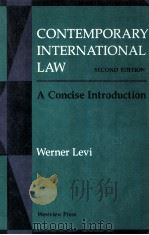
- CONTEMPORARY INTERNATIONAL LAW A CONCISE INTERODUCTION SECOND EDITION
- 1991 WESTVIEW PRESS
-

- INTERNATIONAL LAW SECOND EDITION
- 1976 LONDON BUTTERWORTHS
提示:百度云已更名为百度网盘(百度盘),天翼云盘、微盘下载地址……暂未提供。➥ PDF文字可复制化或转WORD
